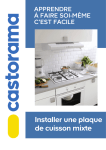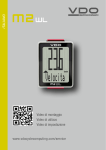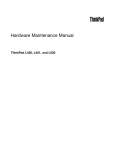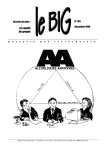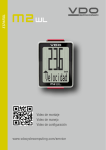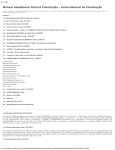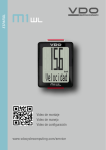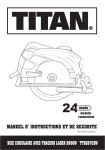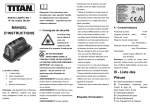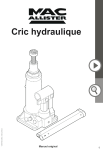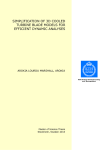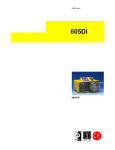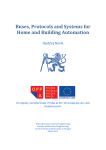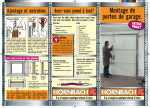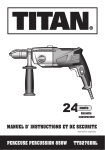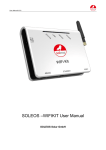Download Basic Requirements for WEEE Directive
Transcript
Basic Requirements for WEEE Directive Updated: Mar 2009 Prepared by: KSO Quality Assurance Waste Electrical and Electronic Equipment (WEEE) Directive. WEEE Directive (2002/96/EC) has already been enforced on 13th August 2005. In order to ensure that the electrical and electronic products for Kingfisher Operating Companies (OpCos) are fully complied with this directive, Kingfisher Oversea Sourcing Offices (OSOs) need to make sure that all products shipped to Europe are in compliant with following requirements requested by Kingfisher OpCos. Categories covered by WEEE Large Household Appliances 2. Small Household Appliances 3. IT and Telecommunications Equipment 4. Consumer Equipment 5. Lighting Equipment 6. Electrical and Electronic Tools 7. Toys, Leisure and Sports Equipment 8. Medical Devices 9. Monitoring and Control Instruments 10. Automatic Dispenser 1. Exemptions of the Directive 1. 2. 3. 4. 5. 6. Filament Light Bulbs Household Luminaires Large-scale stationary industrial tools Military or national security use – not accessories like computers for general use within defence Implanted and infected medical devices As part of non-covered device like Car Hifi For more information and exemptions for WEEE, please visit the link below: http://ec.europa.eu/environment/waste/weee/ KQA-GDL-0003 WEEE Update Mar 2009 Page 2 of 14 There are number of points which we should take action for the compliance with WEEE Directive: 1. Add the “Crossed-out wheeled bin symbol with solid bar underneath” to the product (rating plate) and instruction manual. 2. Add the “Date of manufacture” to the product (rating plate) and the product packaging. 3. Add Producer identifications 4. Add specific text to instruction manual. 5. Add “Identification Marks” on all plastic parts. 6. Create a component list (bill of material) for every product. 7. Ensure the product design allows for dismantling to enable component recovery for reuse and recycling. The following pages will details the requirement of each point. During the silver seal sample evaluation stage, Kingfisher OSO QA should check all these points precisely and comment where n ecessary. Any missing points must be improved in gold seal sample stage. Otherwise, Kingfisher OSO QA will not sign off the gold seal sample. KQA-GDL-0003 WEEE Update Mar 2009 Page 3 of 14 Point 1. Add the “Crossed-out wheeled bin symbol” to the product and instruction manual. The crossed-out wheeled bin symbol with solid bar underneath according to latest EN50419 (Figure 1) must be put legibly and durably on rating plate (Figure 2) and instruction manual. The symbol size should not be less than 7mm in height. If size of the product means that the marking cannot be applied on the product, the marking shall be included in the instruction manual and on the packaging. Overall height > 7 mm Figure 1. Crossed-out wheeled bin symbol KQA-GDL-0003 WEEE Update Mar 2009 Figure 2. Example of Crossed-out wheeled bin and date of manufacture on rating label Page 4 of 14 Point 2. Add the “date of manufacture” to the product (rating plate) and the product packaging. The date must be in the format of two-digit year followed by W, followed by two-digit calendar week, e.g. 04W25 represents year 2004 calendar week 25 (Figure 2.). The date must be printed visibly, legibly and indelibly. It should reflect the manufacturing week accordingly. In addition to satisfying a requirement of the WEEE Directive, the ongoing inclusion of this date of manufacture will assist us when controlling the implementation of the forthcoming Reduction of Hazardous Substances (RoHS) Directive. (This is in addition to any existing instruction requiring “serial number” or “order number” to be shown). KQA-GDL-0003 WEEE Update Mar 2009 Page 5 of 14 Point 3. Add “producer identifications” to the product (rating label) The Producer Identifications for different Opcos are: B&Q Castorama France Castorama Poland Horbach Koctas Brico Depot Screwfix Trade Depot : B&Q SO53 3YX : CASTORAMA France - 59175 TEMPLEMARS : Castorama Polska Sp. z o.o. ul. Krakowiaków 78; 02-255 Warszawa : Hornbach Baumarkt AG, 76878 Bornheim / Germany : KOÇTAŞ YAPI MARKETLERİ TİC. A.Ş. (KOC 34788) : Brico Depot – 30/32 rue de la Tourelle – 91 310 Longpont / Orge France : SFD LTD BA22 8RT : TDSO150LE NOTE: As there are many brand names under Opcos, please check KSO Quality Assurance for exact producer identification. KQA-GDL-0003 WEEE Update Mar 2009 Page 6 of 14 Point 4. Add “Environmental Protection” to instruction manual. “Waste electrical products should not be disposed of with household waste. Please recycle where facilities exist. Check with your local authority or retailer for recycling advice.” Note: This is a general message which is used to translate in corresponding languages in case the products are shipped to France, Germany, Italy, and Poland…etc. Opcos have the decision to change the text in order to fit their local requirements. Environmental Protection Plug Replacement This appliance is supplied with a BS1363 3 pin plug fitted with a 3 A fuse. Should the fuse require replacement, it must be replaced with a fuse rated at 3 A and approved to BS1362. In the event the mains plug has to be removed/replaced for any reason, please note: The wires in the mains lead on this appliance are coloured in accordance with the following code: Blue – Neutral Brown – Live Waste electrical products should not be disposed of with household waste. Please recycle where facilities exist. Check with your Local Authority or retailer for recycling advice. As the colours may not correspond with the markings identifying the terminals in your plug proceed as follows. The blue wire must be connected to the terminal marked N or coloured black. The brown wire must be connected to the terminal marked L or coloured red. Important - any cut off plug should be disposed of safely to prevent hazard. There is a danger of electric shock if a cut off plug is inserted into a socket outlet. Conformity with Directives This product is CE marked to denote conformity with Directives 73/23/EEC(Low Voltage) and 89/336/EEC (Electromagnetic Compatibility), as amended. Environmental Protection Waste electrical products should not be disposed of with household waste. Please recycle where facilities exist. Check with your Local Authority or retailer for recycling advice. Figure 3. Statement and crossed-out wheelie bin symbol in instruction manual KQA-GDL-0003 WEEE Update Mar 2009 Page 7 of 14 Point 5. Add “Identification Marks” on all plastic parts. Size permitting, these marks should appear on all plastic parts of the products and packaging (for example, ABS where appropriate). Preferably, the identification mark should be in “SPI-type”. However, well-recognized identification marks are still acceptable (Figures 4-6). Figure 4. Nylon 6 + 30% Glass fiber KQA-GDL-0003 WEEE Update Mar 2009 Figure 5. SPI Polypropylene mark Figure 6. ABS Page 8 of 14 Point 6. Create a component list (bill of material) for every product. According to WEEE Directive, there are recovery, component reuse and recycling targets which producers need to achieve by 31 st December 2006. It is necessary for us to know the detail weight of all non-recoverable and recoverable components for each product. By the means of component list for WEEE, the information will be assessed and recorded by Kingfisher OSOs & Opcos. It is a critical judgment point for WEEE compliant. The following (Table 1.) listed the targets for each category: Category of electrical and electronic equipment 1 2 Large household appliances Small household appliances IT and telecommunications 3 equipment 4 Consumer equipment 5 Lighting equipment 6 Electrical and electronic tools Toys, leisure and sports 7 equipment 8 Medical devices Monitoring and control 9 instruments 10 Automatic dispensers The definitions of “Reuse” and “Recycling” in WEEE Directive (2002/96/EC) are: Rate of Recovery (% by weight) Component, material and substance reuse and recycling (% by weight) Remark 80 70 75 50 - 75 65 - 75 70 70 65 50 50 - 70 50 - - - Not stated in Directive 70 50 - 80 75 - - “Reuse” means any operation by which WEEE or components thereof are used for the same purpose for which they were conceived, including the continued use of the equipment or components thereof which are returned to collection points, distributors, recyclers or manufacturers. - “Recycling” means the reprocessing in a production process of the waste materials for the original purpose or for other purpose, but excluding energy recovery which means the use of combustible waste as a means of generating energy through direct incineration with or without other waste but with recovery of the heat. Table 1. WEEE targets for rate of recovery, reuse and recycling. KQA-GDL-0003 WEEE Update Mar 2009 Page 9 of 14 Point 7. Create a component list (bill of material) for every product. (…cont.) A component list must be fully detailed and show all parts of the product, including chemicals used in plating, types of plastic, individual weight and gross weight…etc. COMPONENT LIST FOR WEEE Product Description Opco Item Code Factory Item Code Brand Vendor Name ABC Company Limited Factory Name XYZ Manufacturing Company Net Weight (grams) 1000 Date 20-Dec-04 Revision 0 15cm Desk Fan 123456 FT15 ABC Item Number Component Description Material Non-Recoverable Recoverable Component Material Content Identification Component Weight Weight (grams) (Y/N) (grams) 1 2 3 4 5 6 7 8 Front Guard Rear Guard Blade Base + neck Switch Motor Center Piece Rear Case ABS ABS ABS ABS Various materials Various materials ABS ABS Y Y Y Y N Y Y Y 20 Recoverable weight & % 98 98 200 255 0 215 20 50 (grams) 936 Recoverable Weight % to Net Weight (%) 9.8% 9.8% 20.0% 25.5% 0.0% 21.5% 2.0% 5.0% % 93.6% Click here to get the file Figure 7. Example of Component List for WEEE KQA-GDL-0003 WEEE Update Mar 2009 Page 10 of 14 Point 8. Ensure the product design allows for dismantling to enable component recovery for reuse and recycling. Specific design features or manufacturing processes should not prevent WEEE from being reused, except when presented with an overriding advantage such as safety requirements. Always consider the target percentage of recovery, reuse and recycling at the design stage. KQA-GDL-0003 WEEE Update Mar 2009 Page 11 of 14 Frequently Asked Questions: 1. Which products are affected by WEEE Directive? Ans.: According to ANNEX 1A of Directive 2002/96/EC, categories of electrical and electronic equipment covered by WEEE are: Small household appliances. Large household appliances. IT and telecommunications equipment. Consumer equipment. Lighting equipment. Electrical and electronic tools (except large scale stationary industrial tools). Toys, leisure and sports equipment. Medical devices (with the exception of implanted and infected products). Monitoring and control instruments. Automatic dispensers. 2. What is the different between the symbols of crossed-out wheeled bin with the solid bar and crossed-out wheeled bin without solid bar? Ans.: The crossed-out wheeled bin symbol with a solid bar underneath is to be used for identifying the electrical and electronic equipment put on the European market after 13 August 2005. 3. Do we need to put the solid bar under the crossed-out wheeled bin as referenced to latest EN50419? Ans.: Yes, according to Kingfisher requirement, date of manufacture has to be put onto the rating plate with the wheeled bin symbol with solid bar underneath. This satisfies the requirement in latest EN50419. KQA-GDL-0003 WEEE Update Mar 2009 Page 12 of 14 Frequently Asked Questions (…cont.): 4. When the plastic materials used are not shown in the 7 SPI symbols, which markings shall be used? Ans.: It is understood that 7 SPI-type plastic symbols cannot fit for all type of plastic materials currently exist. The commonly used plastic identification symbols (Figure 4-6) are considered as acceptable. It is highly recommended to consult the corresponding QA Technologist where necessary. 5. Are those repeat orders for existing products also need to fill in the component list? Ans.: Yes. Whenever the electrical and electronic equipment ship and enter European market after 13 August 2005. They should fulf ill the Basic WEEE requirements. It is time to clear up the backlog. Take action to put all the required information and compone nt list in advance. 6. Which plastic parts should be marked? In case the plastic part is very small, is it necessary to do so? Ans.: Where possible, all plastic parts should be identified with proper identification mark to indicate its material. However, if the part is weight below 25g. Kingfisher considers that it is not enforced to put the marking in place. 7. Should the plastic identification mark be engraved onto the plastic part only? Ans.: Yes, the most economical and environmental way is to put the identification mark onto the plastic tooling. It is not recomme nded to use printing or labeling for this mark. ***************************** END ***************************** KQA-GDL-0003 WEEE Update Mar 2009 Page 13 of 14 Reference: 1. Directive 2002/96/EC For more and latest information, please visit the link below: http://ec.europa.eu/environment/waste/weee/ 2. WEEE DIRECTIVE - (for B&Q Branded Products), refer latest B&Q Vendor’s Manual, B&Q Social Responsibility. KQA-GDL-0003 WEEE Update Mar 2009 Page 14 of 14














